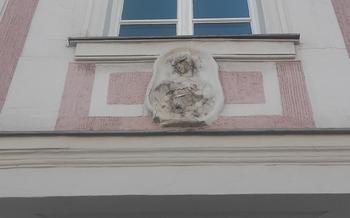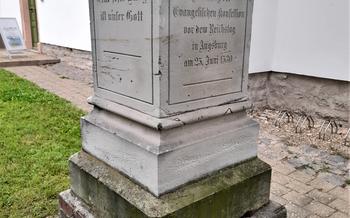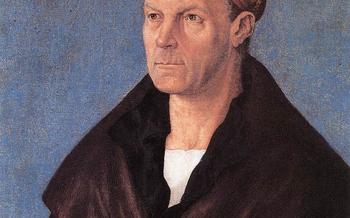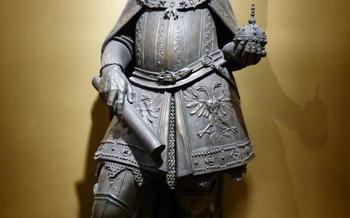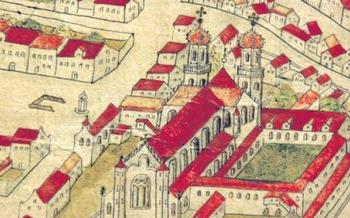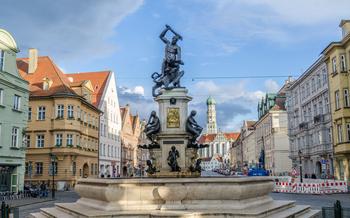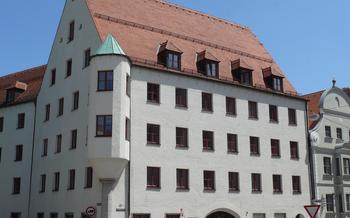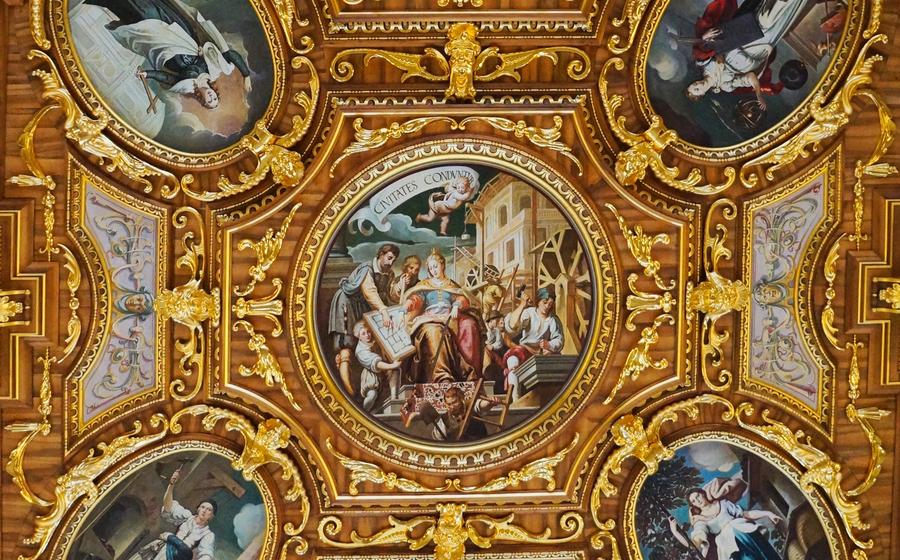
The Goldener Saal (Golden Hall)
- The Golden Hall in Augsburg
- History of the Golden Hall
- Architecture of the Golden Hall
- The Golden Hall as a Cultural Landmark
- Visiting the Golden Hall
- Highlights of the Golden Hall
- Significance of the Golden Hall for Augsburg
- The Rathaus (Town Hall) of Augsburg
- The Fuggerei Social Housing Complex
- St. Ulrich's and St. Afra's Abbey
- Mozart's House in Augsburg
- Augsburg Cathedral
- Augsburg Zoo
- Augsburg Botanical Garden
- Insider Tip: Hidden Gems
The Golden Hall in Augsburg
The Goldener Saal (Golden Hall) in Augsburg, Germany, is a magnificent Renaissance masterpiece renowned for its breathtaking ceiling paintings, intricate decorative elements, and profound historical significance. Built in the 17th century, this opulent hall served as a grand reception space for the city council and hosted numerous pivotal events that shaped Augsburg's destiny. The Golden Hall stands as a testament to the city's wealth, power, and artistic prowess, captivating visitors with its opulent grandeur and rich cultural heritage.
Located within the historic Rathaus (Town Hall), the Golden Hall is a true jewel of Augsburg's architectural wonders. Its grand entrance, adorned with ornate carvings and intricate ironwork, sets the stage for the splendor that awaits within. Step inside, and prepare to be awestruck by the hall's awe-inspiring dimensions, intricate ceiling paintings, and a wealth of decorative elements that tell the story of Augsburg's illustrious past.
History of the Golden Hall
The origins of the Golden Hall can be traced back to the mid-13th century when the city of Augsburg embarked on an ambitious project to construct a grand town hall that would reflect its growing wealth and power. The hall was initially conceived as a venue for important civic functions and events. The construction of the hall was entrusted to the renowned architect Elias Holl, who set about creating a masterpiece that would blend Gothic and Renaissance influences.
The Golden Hall was completed in 1620 after nearly a decade of construction. It was inaugurated with a lavish ceremony that showcased the hall's grandeur and the city's pride in its new treasure. The hall quickly became the focal point of Augsburg's political and cultural life, hosting important meetings of the city council, lavish banquets, and prestigious events.
Over the centuries, the Golden Hall has undergone several changes and renovations. It was extensively restored in the 19th century when the original Renaissance-style ceiling paintings were uncovered and restored to their former glory. In the 20th century, the hall underwent further renovations to ensure its preservation and to adapt it to modern requirements.
Today, the Golden Hall stands as a testament to Augsburg's rich history and cultural significance. It continues to serve as a venue for official functions and prestigious events, while also attracting visitors from around the world who come to marvel at its beauty and historical importance.
Architecture of the Golden Hall
The Golden Hall boasts impressive dimensions, with a remarkable length of 57 meters, a width of 14 meters, and a towering height of 11 meters. Its spacious layout features a central nave, flanked by two aisles separated by elegant rows of columns. The ceiling of the hall is a true masterpiece, adorned with stunning paintings and frescoes that depict scenes from mythology, history, and religion. These intricate artworks were created by the renowned German artist Hans Holbein the Younger and his team of talented craftsmen.
The decorative elements of the Golden Hall are equally captivating, showcasing the intricate craftsmanship of the Renaissance period. The walls are adorned with beautifully carved wooden panels, while the windows feature exquisite stained glass depicting biblical narratives and heraldic symbols. The hall is further embellished with ornate chandeliers, tapestries, and sculptures that contribute to its opulent and awe-inspiring ambiance.
Beyond its aesthetic beauty, the architecture of the Golden Hall also holds profound symbolic meanings. The central nave represents the path of life, with the side aisles symbolizing the choices and experiences that shape our journey. The ceiling paintings depict stories of virtue, wisdom, and justice, serving as moral guides for those who gather within the hall. The overall design of the Golden Hall reflects the deep connection between art, history, and spirituality, making it a place of contemplation and inspiration for visitors from all walks of life.
The Golden Hall as a Cultural Landmark
The Golden Hall's cultural significance extends far beyond its physical presence. It is widely recognized as a masterpiece of Renaissance architecture and an embodiment of Augsburg's rich history. The hall's awe-inspiring interior and historical significance have earned it a place among the city's most iconic landmarks. It is a symbol of Augsburg's wealth, power, and cultural achievements.
The Golden Hall's cultural importance is further underscored by its inclusion in various heritage trails and cultural routes. These trails, such as the "Romantic Road" and the "Via Claudia Augusta," highlight the region's significant historical and cultural sites. By being part of these trails, the Golden Hall attracts visitors from around the world who are eager to explore Germany's rich cultural heritage.
Preservation efforts have been instrumental in maintaining the Golden Hall's grandeur and cultural significance. The city of Augsburg, in collaboration with heritage organizations, has undertaken meticulous restoration and conservation projects to ensure the hall's longevity. These efforts have been successful in preserving the hall's original features, allowing visitors to experience its splendor as it was intended.
Visiting the Golden Hall
Visiting the Golden Hall in Augsburg is an enriching experience that offers insights into the city's rich history and stunning architecture. The hall is open to the public during specific hours, with guided tours available to provide in-depth knowledge and historical context. Visitors can also explore the hall at their own pace, immersing themselves in its grandeur and intricate details.
The Golden Hall is wheelchair accessible, ensuring that everyone has the opportunity to marvel at its splendor. Amenities such as restrooms and a cloakroom are available for the convenience of visitors. To maintain the hall's pristine condition, a dress code is enforced, encouraging visitors to dress respectfully.
Admission fees are charged for entry, with discounts available for students, seniors, and groups. Guided tours require an additional fee, offering an immersive experience led by knowledgeable guides. Visitors are advised to check the official website or contact the Augsburg tourism office for the most up-to-date information on opening hours, admission fees, and guided tour schedules.
Highlights of the Golden Hall
The Golden Hall boasts several notable highlights that have played a significant role in Augsburg's history and culture. One such highlight is the Hercules cycle, a series of 16 ceiling paintings depicting the legendary labors of Hercules. These vibrant and dynamic frescoes, created by Hans Holbein the Younger, showcase the artist's mastery and contribute to the hall's opulent atmosphere.
Another significant highlight is the Augsburg Confession, a document of great importance in the history of the Protestant Reformation. This confession, drafted by Martin Luther and Philipp Melanchthon, was presented to Emperor Charles V at the Diet of Augsburg in 1530. It outlined the beliefs and practices of the Lutheran Church and played a crucial role in shaping the religious landscape of Germany.
The Peace of Augsburg, signed in 1555, is another notable event associated with the Golden Hall. This treaty, negotiated within the hall's walls, brought an end to the religious wars between Protestants and Catholics in the Holy Roman Empire. The Peace of Augsburg established the principle of cuius regio, eius religio, whereby the religion of the ruler determined the religion of the state.
Finally, the Golden Book of Augsburg is a valuable historical artifact housed within the Golden Hall. This book contains the names of all the mayors, city councilors, and other prominent citizens of Augsburg from the 13th century onwards. It serves as a testament to the city's rich history and the important role played by its leaders.
Significance of the Golden Hall for Augsburg
The Golden Hall holds immense significance for the city of Augsburg, transcending its architectural and cultural value. It stands as a symbol of the city's wealth, power, and prosperity during its golden age, when Augsburg was a major center of trade and commerce in the Holy Roman Empire. The hall's opulent decorations and grand dimensions reflect the city's flourishing economy and its status as a prominent imperial city.
Throughout history, the Golden Hall has played host to numerous important events that have shaped the course of Augsburg's development. It has witnessed the signing of the Augsburg Confession in 1530, a pivotal document in the history of the Protestant Reformation, and the Peace of Augsburg in 1555, which established religious tolerance in the Holy Roman Empire. These events underscore the hall's role as a crucial venue for political and religious negotiations that had far-reaching consequences for Germany and Europe.
The Golden Hall is not only a symbol of Augsburg's past but also a source of pride for its citizens. Its preservation and restoration have been a priority for the city, demonstrating its commitment to safeguarding its rich cultural heritage. The hall's continued use for prestigious events and ceremonies reinforces its status as a living symbol of Augsburg's enduring significance.
The Rathaus (Town Hall) of Augsburg
Standing majestically beside the Golden Hall, the Rathaus (Town Hall) of Augsburg is an architectural marvel that mirrors the city's rich history and significance. Constructed between the 13th and 17th centuries, this magnificent edifice has witnessed pivotal moments in Augsburg's past. Its intricate Gothic facade, crowned by a Renaissance gable, reflects the city's transition from a medieval trading hub to a prominent center of the Renaissance.
Inside the Rathaus, visitors are greeted by a grand staircase leading to the Golden Hall. The Rathaus was not only the seat of the city government but also a venue for important events, including the signing of the Peace of Augsburg in 155This historic document established religious tolerance in the Holy Roman Empire, making Augsburg a symbol of peaceful coexistence.
A visit to the Rathaus is an opportunity to delve into the heart of Augsburg's past and to witness the architectural fusion of Gothic and Renaissance styles. The Rathaus, with its close proximity to the Golden Hall, epitomizes the city's rich history and cultural heritage.
The Fuggerei Social Housing Complex
Augsburg boasts a unique and intriguing social housing complex known as the Fuggerei, founded in 1516 by the wealthy Fugger family. This remarkable complex is the oldest surviving social housing project in the world, providing affordable housing for Augsburg's needy residents. The Fuggerei consists of 67 houses arranged in narrow streets, creating a charming and picturesque neighborhood within the city center. Each house comprises two small apartments, and residents pay a symbolic rent of one Rhenish guilder per year, a tradition that has remained unchanged for centuries. The Fuggerei is not only a historical landmark but also a living community, embodying the principles of social responsibility and community support. Visitors can explore the complex and gain insights into its unique history and social significance by joining guided tours or exploring independently. The Fuggerei stands as a testament to the Fugger family's philanthropy and serves as a reminder of Augsburg's rich history.
St. Ulrich's and St. Afra's Abbey
Historical significance
St. Ulrich's and St. Afra's Abbey is a former Benedictine monastery located in Augsburg, Germany. It was founded in the 8th century and played a significant role in the religious and cultural life of the city. The abbey was dedicated to Saint Ulrich, Bishop of Augsburg, and Saint Afra, a Christian martyr.
Architectural highlights
The abbey church is a masterpiece of Romanesque architecture, with its distinctive twin towers and elaborate interior. The church is home to several important works of art, including the bronze statue of St. Ulrich and the stained glass windows depicting scenes from his life.
Relation to the Golden Hall
The abbey is located just a short walk from the Golden Hall and is often visited in conjunction with the city's other top attractions. The abbey and the Golden Hall are both important symbols of Augsburg's rich history and cultural heritage.
Location and visiting information
St. Ulrich's and St. Afra's Abbey is located at Ulrichsplatz 11, 86152 Augsburg, Germany. The abbey is open to visitors daily from 10:00 AM to 5:00 PM. Admission is free.
Mozart's House in Augsburg
The city of Augsburg boasts a rich musical heritage, and one of its most notable landmarks is the Mozart's House, located on Frauentorstraße, just a short walk from the Golden Hall. This charming and historically significant building is where the renowned composer Wolfgang Amadeus Mozart resided during his stay in Augsburg in 177
Mozart, then a young prodigy of 21, arrived in Augsburg to perform at the court of Prince-Bishop Clemens Wenzeslaus. He stayed at the house, which was owned by the prominent Mozart family, for several weeks, during which time he composed several works, including the Symphony No. 31 in D major, known as the "Paris" Symphony.
The house itself is a beautifully preserved example of 18th-century architecture, with its elegant façade, intricate stucco decorations, and a charming courtyard. Inside, visitors can explore various exhibits and artifacts related to Mozart's life and work. These include original manuscripts, portraits, and personal belongings, providing a glimpse into the creative genius of the young composer.
The Mozart's House in Augsburg stands as a testament to the city's rich cultural heritage and its connection to one of the most celebrated musicians in history. It is a must-visit for music enthusiasts, history buffs, and anyone interested in exploring the life and legacy of Wolfgang Amadeus Mozart.
Augsburg Cathedral
Augsburg Cathedral, officially known as the Cathedral of the Holy Virgin Mary, is another architectural and historical landmark in Augsburg. Founded in the 11th century, it is considered one of the oldest and most prominent cathedrals in Germany. The cathedral boasts a unique mix of architectural styles, including Romanesque, Gothic, and Baroque, reflecting various periods of its construction and renovation.
The exterior of the cathedral is characterized by its imposing towers, intricate portals, and beautiful stained glass windows. The interior is equally impressive, featuring a spacious nave, impressive vaulted ceilings, and a stunning high altar. Visitors can admire numerous works of art, including sculptures, paintings, and frescoes that adorn the cathedral's interior.
The cathedral is not only a religious site but also a significant cultural and historical landmark. It has witnessed many important events throughout Augsburg's history, including imperial diets, religious ceremonies, and coronations. The cathedral also played a crucial role during the Protestant Reformation, as it was here that the Augsburg Confession was presented in 1530.
Augsburg Cathedral is located in the heart of the city, near the Rathaus and the Golden Hall. It is easily accessible by foot or public transportation, making it a popular destination for both locals and tourists. Visitors can explore the cathedral independently or join guided tours to learn more about its rich history and architectural significance.
Augsburg Zoo
Augsburg Zoo, situated in the picturesque Haunstetten district, offers a delightful escape into the world of wildlife. Founded in 1937, it has grown into a modern zoological park spanning over 20 hectares. Visitors are captivated by the diverse range of animal species, including majestic lions, playful monkeys, elegant giraffes, and a host of exotic birds.
The zoo is renowned for its commitment to animal welfare and conservation. Spacious enclosures replicate natural habitats, allowing animals to thrive in environments that mimic their native surroundings. Visitors can witness the fascinating behavior of these creatures as they roam freely, interact with each other, and engage in their natural instincts.
Educational programs and interactive exhibits play a crucial role at Augsburg Zoo. Guided tours provide insightful commentary on animal behavior, conservation efforts, and the importance of protecting endangered species. Children and adults alike are enthralled by the opportunity to learn about wildlife up close, fostering a sense of empathy and appreciation for the natural world.
The zoo's commitment to conservation extends beyond its grounds. Augsburg Zoo actively participates in international breeding programs, contributing to the preservation of threatened species worldwide. Visitors can witness the fruits of these efforts in the zoo's breeding facilities and learn about the challenges faced by endangered animals in the wild.
A visit to Augsburg Zoo is not just an encounter with wildlife but also a journey into the realm of conservation and education. Immerse yourself in the wonders of the animal kingdom while gaining a deeper understanding of the importance of protecting our planet's biodiversity.
Augsburg Botanical Garden
A Haven of Serenity and Biodiversity
Located in the heart of Augsburg, the Botanical Garden offers a tranquil oasis for nature enthusiasts and visitors seeking a respite from the bustling city center. Established in 1932 and comprising over 10 hectares of beautifully landscaped grounds, the garden showcases a diverse collection of plants from around the world.
Stroll through the meticulously maintained paths and discover an array of themed gardens, including a rock garden, a rose garden, and a medicinal herb garden. Admire the vibrant colors and delicate fragrances of over 3,000 plant species, representing various habitats and ecosystems.
The garden serves as an important center for botanical research and conservation, contributing to the preservation of endangered plant species and the promotion of sustainable gardening practices. Educational programs and guided tours are available for visitors to learn more about the fascinating world of plants and their significance in our ecosystems.
Whether you're a seasoned botanist, a nature lover, or simply seeking a peaceful retreat, the Augsburg Botanical Garden offers a delightful experience for visitors of all ages. Immerse yourself in the beauty and diversity of the plant kingdom, and discover the hidden treasures that lie within this urban oasis.
Relation to the Golden Hall
While the Botanical Garden may not have a direct historical connection to the Golden Hall, it shares a common thread in terms of cultural and educational significance. Both the Golden Hall and the Botanical Garden represent the rich heritage of Augsburg and its commitment to preserving and showcasing its cultural treasures.
A visit to the Botanical Garden can complement your exploration of the Golden Hall by providing a serene and picturesque setting to reflect on the history and beauty of Augsburg. The garden offers a unique perspective on the city's cultural diversity, showcasing plants from various corners of the globe, much like the Golden Hall reflects the city's historical and architectural influences.
Insider Tip: Hidden Gems
Beyond the must-see attractions, Augsburg offers a wealth of hidden gems waiting to be discovered. Delve into the city's rich history at the Schaezlerpalais, a stunning rococo palace that houses the State Museum of Swabia. Immerse yourself in the world of puppets at the Augsburger Puppenkiste, a renowned puppet theater with enchanting performances for all ages.
Stroll through the picturesque Lechviertel, a charming neighborhood along the Lech River, and uncover hidden courtyards and charming cafes. Don't miss the opportunity to visit the Brecht House, the former residence of renowned playwright Bertolt Brecht, now a museum dedicated to his life and work.
For a unique perspective of the city, embark on a boat tour on the Lech River, offering breathtaking views of Augsburg's skyline. Alternatively, explore the city's green oasis at the Siebentischwald, a serene forest perfect for escaping the hustle and bustle of urban life.
To truly delve into the local culture, join one of the many festivals and events that take place throughout the year. From the colorful Augsburger Plärrer, a traditional fair with rides, food, and music, to the Mozartfest, celebrating the life and work of Wolfgang Amadeus Mozart, there's always something to experience.
Augsburg's hidden gems are waiting to be discovered, offering unique insights into the city's rich history, culture, and charm. Embrace your curiosity, explore beyond the beaten path, and uncover the treasures that lie beneath the surface.
